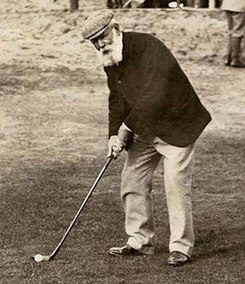Old Tom Morris
Scottish
1821 - 1908

Scottish
1821 - 1908

Born Thomas Mitchell Morris in 1821 in St. Andrews, Fife, Scotland, he would become synonymous with the town, the links, and golf course design itself, as Old Tom Morris. As a player he won five Open Championships, winning the 1862 championship by 13 strokes – a record that stood until Tiger Woods crushed the 2000 U.S. Open field by 15. He was runner up in 1868 to none other than his son, Young Tom Morris, who would go on to win four Open Championships in a row.
Morris apprenticed at St. Andrews under Allan Robertson, the world’s first professional golfer, and become his playing partner to make a nearly unbeatable twosome. From Robertson, Morris learned the golf course business, along with clubmaking and making featherie golf balls. It was the featherie golf balls that caused his immediate firing from St. Andrews when in 1851, he was fired by Robertson for playing a new guttie golf ball. (It sounds ridiculous, but imagine a Callaway exec caught playing a ProV1.) After that round, he moved on to Prestwick Golf Club, where he designed and maintained the new course while selling golf equipment, including gutties, until the Royal and Ancient passed a formal motion to bring him back as Keeper of the Green.
Upon his return, he was charged with getting the Old Course back into shape and he did so by widening fairways, replacing two greens and enlarging others, while also tending to the hazards for the first time.
As a course designer, Morris had a hand in numerous improvements at the Old Course over the years and partnered with Robertson to lay out the original 10 holes at Carnoustie. Other classic courses on his resume dot the British Isles with original designs at the Jubilee Course at St. Andrews, Muirfield, Machrihanish, Prestwick, Lahinch, Royal Dornoch, Carne, and dozens of others in Scotland, Ireland, and England. His stated design fee was typically one pound plus expenses.
Morris is also the father of modern greenskeeping with a slew of innovations and firsts that are commonplace on golf courses today.
While he didn’t invent the sport like James Naismith or Abner Doubleday, without his contribution to the game the sport would not have grown to what it is today, with more than 66 million golfers worldwide. There’s also a book that’s very much worth your time: Tommy’s Honor: The Story of Old Tom Morris and Young Tom Morris, Golf Founding Father and Son
EDITOR’S NOTE: It’s hard to list out original designs as Old Tom took a lot of courses from 9 to 18 or “renovated” the original layout with ancient routings determined by sheep, wind, or a club’s founding members. The “Year Built” on the website is typically the year Tom built an original 9, extensively renovated an existing layout, or added holes to a shorter course. When only redoing a few holes, adding bunkers, or changing greens, as he did at The Old Course at St. Andrew’s, he is not credited with the course design. It’s worth pointing out that there aren’t too many untouched courses created by Old Tom as James Braid, an accomplished course designer in his own right, made a living updating many of Morris’ courses in the 1920’s and 30s.
The Grand Old Man of Golf was the winner of 5 Open Championships, the father of modern greenskeeping, and a prodigious architect with dozens of course designs from Scotland, Ireland, and England.